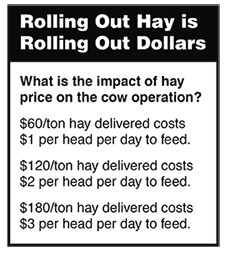
Kris Ringwall
Beef Talk
Feeding calves high-priced hay needs to be a bridge from one low-cost production scenario to the next.
As the year ends, reflecting on the past year is good. The obvious point this year is the lack of forage and how, as producers, one responded to the challenge.
The Dickinson Research Extension Center needs more than 1,000 1,300-pound (lb.) bales to make the stretch to spring grass. That number is buffered a bit because the calves are receiving 3 lb. of commercial supplement daily, and the cows get 4 lb. of commercial supplement every other day. Forage is the essence of a cattle operation, and keeping costs low is critical.
 Fortunately, the center’s forage feed needs have been helped by the more recent good weather. We had a moister fall, followed by a kinder start to winter. Cows have done well on crop aftermath, cover crops and standing corn. Still, many producers are short of forage and have had to purchase hay.
Fortunately, the center’s forage feed needs have been helped by the more recent good weather. We had a moister fall, followed by a kinder start to winter. Cows have done well on crop aftermath, cover crops and standing corn. Still, many producers are short of forage and have had to purchase hay.
Unfortunately, purchasing hay generally drives costs up, and producers view the purchase of hay above operational historical levels as a last resort because of transportation costs. Karl Hoppe, an area livestock specialist with the North Dakota State University (NDSU) Extension Service, noted the impact of hay prices and asked, “Assuming we have limited hay, should I use that hay for wintering the cows and sell calves, or buy hay and feed calves?”
That’s not a simple question because markets shift, and selling calves in a downward-trending market vs. feeding them with the anticipation of a stronger market takes some figuring. If the cost of gain is low enough, the efficiency would say to capture it and feed cattle to harvest.
Anyway, welcome to this year’s cattle business. Whether cows or calves, feeding hay at $60, $120 or $180 per ton delivered has astonishing outcomes. The range in the quality of hay also has been astonishing. The best advice is “buyer beware.” Never buy hay without a feed analysis and always price hay based on that analysis.
For simplicity today, the following example only assumes a look at total pounds of forage, keeping in mind the actual outcome needs to account for the quality of the available feed. The center’s need for 1,000 large round bales is an estimate of feed the center’s 229 calves need (378 tons) and the center’s 145 cows need (278 tons).
Assuming the calves gain 1.5 lb. per day with some supplement, the 378 tons of hay for 180 days is 2.1 tons (4,200 lb.) of forage per day. If the 229 calves gain 1.5 lb. per day for 180 days and the hay costs $60 per ton delivered, then the forage cost for that pound of gain is estimated at 37¢ per pound. At $120 per ton delivered, the forage cost per pound of gain doubles to 74¢ per pound. At $180 per ton delivered, the forage cost per pound of gain triples to $1.11.
Remember, this is just the estimated cost of forage plus transportation. The 2016 backgrounding costs from the North Dakota Farm and Ranch Business Management Education Program (www.ndfarmmanagement.com), along with FINBIN (www.finbin.umn.edu/) from the Center for Farm Financial Management at the University of Minnesota, were 40¢ for calves gaining 1.7 lb. per day with an approximately 70% forage base.
The bottom line: Feeding calves high-priced hay needs to be a bridge from one low-cost production scenario to the next, but not a long bridge.
The same would be true for the cows. The center’s 145 cows need 278 tons for 120 days, or 2.3 tons (4,633 lb.) of forage per day. Each cow would have approximately 32 lb. of forage daily. At $60 per ton delivered, cow forage cost is 96¢, or just under $1 per day. At $120 per ton delivered, the forage cost would be $2 per day; and at $180 per ton delivered, the forage cost would be $3 per day.
In 2016, the FINBIN data showed total feed cost per cow under more normal conditions was $349. Again, that is the total feed cost, and $60-per-ton hay is within reason. However, this year, the increase in hay costs alone could force the total feed cost per cow much higher.
For pondering purposes, if the center would have had to start feeding $120-per-ton hay in November and continue through April, the forage bill alone would have been $360 per cow. Fortunately, winter has held off and weather is milder, so a shorter feeding period is welcome relief.
Even feeding expensive hay starting in January drives up the day cost of a cow. Again, high-priced hay needs to be a bridge from one low-cost production scenario to the next. Unfortunately, once spent, the money must be transferred, and generally, the ability to lower upcoming production costs is limited.
Seeking alternative feed resources and substituting a less costly, more energy-dense feed source as a percentage of the daily ration should be explored. High-cost hay means refining management, penciling out costs per pound of nutrient delivered and consulting a nutritionist for a total ration. Rolling out hay is rolling out dollars.
May you find all your ear tags.

Editor’s Note: Kris Ringwall is a beef specialist for the North Dakota State University Extension Service. For more information, contact your local NDSU Extension Service agent (https://www.ag.ndsu.edu/extension/directory) or Ringwall at the Dickinson Research Extension Center, 1041 State Ave., Dickinson, ND 58601; 701-456-1103; or kris.ringwall@ndsu.edu.






